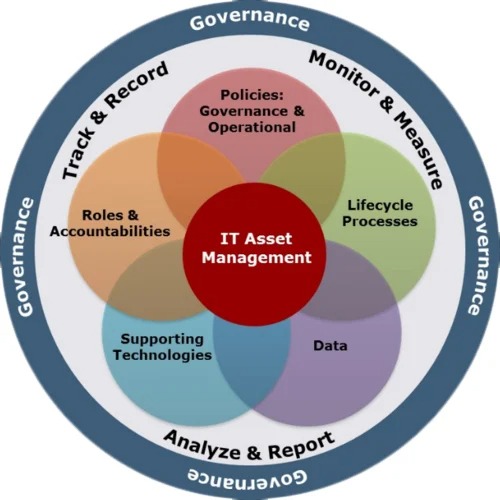IT Asset Management (ITAM) is a set of practices and processes for managing an organization’s IT assets, including hardware, software, networks, and related components. The goal of ITAM is to ensure that IT assets are efficiently and effectively used to maximize value, minimize costs, and manage risks throughout their lifecycle.
Key Objectives of IT Asset Management
- Asset Visibility and Control: Maintain a comprehensive inventory of all IT assets to ensure visibility and control over their usage and deployment.
- Cost Management: Optimize the procurement, utilization, and disposal of IT assets to reduce costs and avoid unnecessary expenditures.
- Risk Management: Mitigate risks associated with IT assets, including compliance, security, and operational risks.
- Lifecycle Management: Manage the entire lifecycle of IT assets from acquisition to disposal to ensure optimal performance and value.
Core Components of IT Asset Management
- Inventory Management:
- Asset Discovery: Use automated tools to discover and inventory all IT assets within the organization.
- Asset Cataloging: Maintain an up-to-date catalog of all IT assets, including detailed information on hardware, software, and network components.
- Procurement Management:
- Standardized Procurement: Implement standardized policies and procedures for acquiring IT assets to ensure cost-effectiveness and compliance.
- Vendor Management: Manage relationships with vendors to negotiate favorable terms and ensure reliable supply of IT assets.
- Asset Deployment and Configuration:
- Deployment Processes: Standardize and automate the deployment of IT assets to ensure consistency and efficiency.
- Configuration Management: Maintain detailed records of asset configurations to support troubleshooting, maintenance, and compliance.
- Usage and Performance Monitoring:
- Usage Tracking: Monitor the usage of IT assets to ensure they are being utilized effectively and identify underutilized or overutilized assets.
- Performance Metrics: Track performance metrics to ensure IT assets are meeting expected performance standards and service levels.
- Maintenance and Support:
- Maintenance Schedules: Implement and adhere to maintenance schedules to ensure IT assets remain operational and secure.
- Support Services: Provide support services to address issues and perform repairs, upgrades, or replacements as needed.
- Compliance and Audit Readiness:
- Regulatory Compliance: Ensure IT assets comply with relevant regulations, standards, and internal policies.
- Audit Preparation: Maintain detailed records and documentation to be prepared for internal and external audits.
- Security and Risk Management:
- Security Policies: Implement security policies and procedures to protect IT assets from threats and vulnerabilities.
- Risk Mitigation: Identify and mitigate risks associated with IT assets, including data breaches, hardware failures, and software non-compliance.
- Disposal and Retirement:
- End-of-Life Management: Manage the retirement and disposal of IT assets in a secure and environmentally responsible manner.
- Data Sanitization: Ensure all data is securely erased from assets before disposal to protect sensitive information.
Benefits of Effective IT Asset Management
- Cost Savings: By optimizing the use and procurement of IT assets, organizations can significantly reduce costs and avoid unnecessary expenditures.
- Improved Efficiency: Streamlined processes for managing IT assets lead to improved operational efficiency and productivity.
- Enhanced Security: Effective ITAM practices help protect IT assets from security threats and ensure compliance with security policies and regulations.
- Better Decision-Making: Comprehensive data and insights on IT assets support informed decision-making and strategic planning.
- Reduced Risk: Proactive management of IT assets helps mitigate risks related to compliance, security, and operational issues.
Popular IT Asset Management Tools and Solutions
- ServiceNow IT Asset Management
- Ivanti IT Asset Management Suite
- ManageEngine AssetExplorer
- BMC Helix Discovery
- IBM Maximo Asset Management
These tools provide features such as asset discovery, inventory management, license tracking, usage monitoring, and compliance reporting to support effective ITAM practices.
Best Practices for Implementing IT Asset Management
- Executive Sponsorship: Secure support from senior management to prioritize ITAM and allocate necessary resources.
- Comprehensive Inventory: Maintain an accurate and up-to-date inventory of all IT assets to ensure visibility and control.
- Standardized Processes: Develop and enforce standardized processes for the procurement, deployment, management, and disposal of IT assets.
- Stakeholder Engagement: Involve key stakeholders from IT, finance, procurement, and other relevant departments to ensure alignment with organizational goals.
- Training and Awareness: Educate employees about ITAM policies and procedures to ensure compliance and effective participation.
- Continuous Improvement: Regularly review and update ITAM processes and tools to adapt to changing business needs and technology advancements.
By implementing robust IT Asset Management practices, organizations can achieve greater efficiency, cost savings, and risk management, ensuring that their IT assets deliver maximum value throughout their lifecycle.
